Comments are in reverse chronological order, most recent first.
15 September 2018
Tesla uses a virtual steering axis front suspension design. This means that the front suspension linkages are arranged in a way that intersects the steering axis through the tire contact patch in a way that both lets the steering very accurately sense the forces on the tire and also enhances the feeling of it for the driver.
Some reviewers have commented about a lack of steering feel at low power, and I concur with this somewhat. Some of the numbness could be exactly due to the presence of the bushings in the virtual steering axis suspension linkages. However at higher lateral forces, the steering comes alive and the feel is greatly enhanced by the design, which allows the driver to extremely clearly feel through the steering wheel what the front tires and the entire chassis are doing through a turn. Some energy is probably needed to bias the bushings into a more linear operating region, like energy stored in a spring. (Indeed the tires themselves also need some energy to load their inherent hysteresis into more linear behavior.) But when it's so loaded, the feel through the steering wheel is exquisite, delicate and highly communicative. This is most noticeable during sustained high power cornering on a race track. During normal street driving, the steering is very slightly numb, but the isolation from road imperfections during typical low performance street driving is probably a benefit to comfort. In short, this is an excellent compromise between low power comfort and high power responsiveness and feel.
6 August 2018
Tesla has opened up the referral program to Model 3 owners,
so I now have a referral code. If you enjoy anything you read
here and/or would like to get free, unlimited Supercharging
when buying a Model S, Model X, or the outstanding, new
Performance Model 3
through 15 September 2018, then please use my referral
code:
https://ts.la/jeff71028
Starting 16 September 2018, using a referral code gives
one year of free Supercharging.
2 August 2018
[Note that this mini-review was written before seeing Road & Track's excellent 3 August 2018 Performance Model 3 beta Track Mode review, dated 3 August 2018 but echoes several of its sentiments.]
I had the opportunity to test drive an early production Performance Model 3 (PM3) at my local Tesla store. Car had about 160 miles on the odometer, so had probably had been on about a dozen test drives. ~35 of the miles were from the delivery drive from the factory in Fremont. This multi-coat red car had basically all the options: white interior, Autopilot, Performance Upgrade option (PUO) with 20 inch wheels, upgraded brakes, 1 cm lower performance suspension, aluminum pedals. The Carbon spoiler included with PUO had not been installed yet. Battery was at about 60% charge, so not at full power.
First, some notes about the interior: the Premium White interior looked good. The white door panel inserts looked harmonious and tasteful, as did the white seats. (To be honest, I wasn't sure if I'd like them.) The white door inserts are soft Ultraleather like the seats and not the artificial suede-like Alcantara of the black interior. The white dashboard trim taking place of the wood veneer had a satin finish that did not cause glare. The resulting interior does feel a bit more special than the Premium Black. I liked it.
Also, since the interior was mostly black with white sections, the bright white was not as overwhelming as in mostly white Model S and X interiors. The mix of contrasting colors was refreshing. Aside from the black center armrest and console, the white interior matched the unveil prototypes, so this color scheme was probably on the minds of the interior designers originally. On a practical note, the white interior may have been a bit cooler in temperature than black on a slightly warm day.
Fit and finish was nearly perfect. I did not spot any obvious defects inside or outside.
Upon getting in any car, I always adjust the seat to be high, with a flat (untilted) bottom cushion and relatively upright back rest. I did not adjust the lumbar support since it felt ok to begin with. I adjusted the steering wheel to point at the center of my chest and have a <135 degree elbow angle when a hand is at the top of the wheel. Also adjusted mirrors, and cinched down seat belt to be low across the lap. All are standard racing practices taught at most racing schools, and are good ergonomics for driving in general. I was able to find a comfortable and largely ergonomically correct seating position, and Model 3 has lots of adjustments to allow further fine tuning.
Settings under the Driving control panel tab were:
I had several goals for the test drive: explore performance limits a bit, explore feel and response of controls and chassis, assess ride comfort versus performance tradeoff of performance suspension and 20 inch wheels with performance-oriented Michelin Pilot Sport 4S tires, test the upgraded brakes a bit and assess their feel and response, etc. Generally wanted to get a sense of how the Performance Model 3 felt to drive, how it responded to inputs, etc.
One of my lasting impressions from Model S P100DL, aside from the almost incomprehensibly rapid acceleration, was the ease with which it moved at low power. The latter is almost more important to me because I care possibly more about the quality of the driving experience than the quantity. P100DL has both.
I wanted to see if Performance Model 3 had some of that ease of low power movement, and whether it could possibly be attributed to the added front motor and AWD. I'm pleased to say that Performance Model 3 did move more easily than single motor Model 3, and it definitely had most of that ease of movement. It was not quite as effortless as P100DL, but the added front motor did seem to bring it much of the way there at low power. In short, AWD may move more easily and feel more effortless at moving than single motor. AWD spreads the work of accelerating over twice as many axles and wheels. Electrical engineers might say AWD has a better impedance match to the road, where the tires are like antennas in a circuit. Non-Performance dual motor probably captures most of that benefit at a much lower price. (One downside of dual motor is an apparent 12% lower EPA efficiency than single motor, perhaps due to the added front drivetrain mass and friction.)
At the speed limit on city streets, there was some front motor whine. Most likely it's actually reduction gear noise and not the motor itself, which spins in roller bearings. As predicted, whine was mostly auditorially masked (made hard to hear) by slight road and wind noise at higher speeds on the highway. There was some barely noticeable wind noise, probably from the glass roof lateral panel gap. (There are aftermarket kits to fill that gap, for example using an EPDM synthetic rubber tube stuffed into the gap.) PM3 with PUO acceleration from zero to 40 MPH was about 2 seconds, compared to about 1 second to 30 MPH from a rolling start in Model S P100DL. Performance Model 3 acceleration is merely insane and not ludicrous! All Teslas are quick. PM3 is noticeably more so than non-Performance Model 3s.
On both surface streets and highway, the ride was comfortable. The shorter sidewall PUO tires and slightly stiffer suspension may have let through a little more noise and vibration from road bumps and highway expansion joints than the softer standard suspension with Aero wheels, but the overall effect was still very comfortable. It takes much skillful development work to arrive at suspension tuning that is both comfortable and performs well. That ride versus handling compromise seems well attained in PM3 with PUO.
Ironically, the standard suspension and hard, energy efficient tires on Aero wheels may ride a bit harsher, due to stiffness of the tires themselves which are optimized for better energy efficiency than a soft ride. In other words, the stiffer suspension with performance tires of PUO versus softer suspension with harder energy tires of Aero wheels may offer somewhat similar overall noise, vibration and harshness (NVH) levels, but with slightly different frequency/time responses. Said another way, NVH may be roughly comparable between them, but may differ a bit in quality.
(As an aside, given that EVs have almost no NVH from their very smooth drivetrains, almost all that remains is probably from the suspension system including wheels and tires. Teslas actually have a small amount of noticeable NVH, but it's probably due to the slight performance bias, like BMW, Audi or Mercedes sporty sedans.)
My test route included some surface streets and a few highway miles, but most relevantly had the same highway onramp cloverleaf that I had tried in the Model S P85 a few years earlier. The cloverleaf is constant radius, banked and rising in elevation, which made it very easy and safe to drive at fairly high power. Also the curve leads into a protected straight where the merge lanes don't appear until several hundred meters ahead. There was lots of room to power out of the turn with no possibility of merging traffic, as we tried below.
There were no other cars at all in the area of the onramp, so I gave it moderately strong throttle going into the turn. The car responded well, so I increased power to the point where I got a little tire noise and may have started to tickle the stability control intervention, call it 0.7+ g: certainly harder than most people normally drive on the street. Key to doing that is to never lift off the throttle as that could lead to trailing throttle oversteeer. Always keep the throttle steady or increase it gradually in a below-limit turn, in order to keep the rear end planted. Said another way, this keeps load transferred onto the rear wheels, discouraging it from stepping out. Exiting the turn, I gave it full throttle, rolling into the accelerator smoothly and gently as the radius blended into the long, protected straight. Acceleration out of the turn was like a freight train, if freight trains could do more than a half g of acceleration at 60+ MPH. Very impressive and fast. On a race track this would translate into strong acceleration out of turns, something the non-Performance Model 3 (and really any EV) also has to a lesser extent.
(As a minor aside, it should be ok to call the accelerator on an EV a throttle. The motor controller limits the flow of current from the full battery pack voltage to the motor by chopping the DC into high frequency pulses of variable width. It is literally throttling the full pack voltage into an effectively lower voltage as seen by the motor; an EV motor controller, as commanded by the accelerator pedal, is figuratively and literally a fast-reacting throttle.)
Comparing the early Model S P85 to Performance Model 3 with Performance Upgrade option, while the early Performance Model S at moderately high Gs did surprisingly well in this turn for a large and very heavy car, the smaller and 20% lighter PM3 with PUO did it much more effortlessly, gracefully and controllably. Throughout the turn, the throttle and chassis response was linear, predictable, consistent, and highly communicative. Feedback from PM3 with PUO was clear and immediate, and driving not too far from the limits was extremely easy. Anyone with performance driving experience could do it all day long with little stress and minimal effort. That is the mark of a great car.
To put things in perspective better, both Model 3 and Model S are relatively heavy cars. While Tesla mitigated the weight penalty of battery packs particularly well in Model 3, and Model 3 is within about 10% of the mass of BMW 3 series, it's still somewhat heavy. However the excellent chassis design of all Teslas minimizes the effect of that mass and results in surprisingly delicate controls. That the strategies can be so effective in much heavier Model S did not fully prepare me for how much better they are in much lighter Model 3. PM3 with PUO is exquisitely fine in how it conveys feel and feedback. Shockingly really. Performance Model S is merely great for its high weight. Performance Model 3 with the suspension and tire upgrades is a very large step better in driving feel.
It's worth mentioning here that some of the great steering feel is a result of the virtual steering axis front suspension design that Tesla and others use. Its purpose is to move an artificial steering axis around the tire contact patch in order to enhance the feel through the steering of the forces acting on the tires. It does this by clever arrangement of the suspension linkages and very careful tuning of the bushing responses for those linkages. The result is that forces acting on the contact patch in all directions are more clearly felt through the steering wheel as the car moves through direction changes. It sounds complicated, but the bottom line is that the virtual steering axis front suspension works superbly well in Performance Model 3, and makes the steering highly communicative about exactly what the front tires are doing.
Obviously we did not exceed any of the car's physical limits during a brief test drive on public roads. Doing so on a race track would be a good measure of how the car responds beyond its limits. However doing so would require either Tesla's beta Track Mode or Sasha's stability and traction control defeat tools. Sasha's track video was impressive and showed a modified Long Range Model 3 with excellent balance and driveability at the limits. Behavior beyond the limits with stability controls disabled looked good too.
Back to our test drive, friction braking at say 0.3 g coming to a somewhat unexpected stop at the top of an offramp was smooth and progressive, and brake feel was excellent. As with the suspension, steering and throttle, brake operation was linear, responsive and highly communicative. The brake pedal was firm, not over boosted, and had excellent feel and response. This is a very competently done braking system. That said, these are nearly racing brakes, and it would be more informative to try them on a race track, possibly with a pad upgrade if needed.
I did not do any high power braking as one might do in an emergency on the street or before every turn of a race track. For normal driving in traffic, brake operation and feel were excellent. Even with the Low Regen setting, there was some regenerative braking at low to medium speeds, which was similar to single motor Model 3s. All of my braking was with Low Regen, i.e., almost entirely the friction brakes. Please see my comments about why regen belongs on the brake pedal. I still wish Tesla would add a user-selectable option to have regenerative braking integrated with friction braking on the brake pedal. There are many reasons why this is ergonomically superior, and almost every other EV has regen integrated with the brake pedal, in addition to having some light regen on throttle lift to simulate automatic transmission drag. The latter is similar to Tesla regen set to Low.
Overall impressions are of a car that moves with great ease, has high limits, is very easy to drive, and is highly communicative and linear near its limits. Some of the cause of the preceding is surely the result of finding and reducing friction throughout the drivetrain and suspension. More important is starting from an exceptionally good mechanical design that includes a virtual steering axis front suspension similar to Audis, multi link rear suspension similar to recent Ferraris, and a very low center of gravity with the considerable mass of the battery pack far below the wheel centers. The electrical design is also excellent and world leading. For example, Model 3 is the first major EV application of highly efficient permanent magnet reluctance motors and Silicon Carbide motor controllers. Having all wheels driven with the dual motors seemed to add much of the the effortless movement at low power that I was seeking.
Performance Model 3 is a superb car. Being electric benefits the excellent chassis design and resulting handling by providing highly predictable, usable, linear and consistent torque instantly on demand. And the whole is greater than the sum of its parts. It's not just that all the individual performance aspects are superlative, it's how they work together to make a car that's ridiculously easy to drive well from low through high power and offers telepathic feedback straight from the tires while doing so.
All evidence points to PM3 handily outperforming BMW M3 on race tracks, given that Sasha Anis' modified single-motor, non-Performance, Long Range Model 3 at 1:18.9 was 1.4 seconds quicker than BMW M3 admittedly on a relatively slow track. A much more powerful modified Performance Model 3 should devour BMW's M3 race track records easily, which would be kind of shocking, no pun intended. Anyone interested in a performance car must try Performance Model 3 if they want to be aware of all that's available.
Some areas of possible improvement: I plan to get lightweight racing wheels, probably 18 or 19 inch Enkeis and possibly stickier street tires such as RE-71R. The PUO Michelin Pilot Sport 4S tires are excellent, but the 20 inch wheels are probably relatively heavy. Racing wheels may shed more than 1/3 of their mass. Lighter wheels make any car accelerate quicker due to lower rotational inertia and handle better due to having less unsprung mass to accelerate up and down, for example over bumps or through every turn. I may also change to a coilover suspension from Sasha's MPP or Unplugged Performance to further improve the handling, but only if they also offer relatively comfortable ride. The ride versus comfort compromise of the factory Performance Upgrade option was very good. It was developed on race tracks, after all.
Due to its combination of virtues, Performance Model 3 moves and operates so effortlessly and seamlessly that it's hard to imagine any combustion car able to move as competently. I liked how the very heavy and large Model S P100DL moves, but Performance Model 3 is so much lighter on its feet that it overachieves much more easily. Performance Model 3's communication with the driver is so much finer and more delicate that, aside from some family resemblance between the engineering architecture of S and 3, they're not directly comparable.
Comparing Performance Model 3 to Long Range single motor Model 3, PM3 is like regular Model 3 on steroids. Everything is faster, reactions are sharper, limits are higher, and communication is clearer. This is appropriate to a more performance-oriented car. My prior LR Model 3 test drive was on city streets, and I did push it hard in turns a few times, but did not have a high speed turn to try. What's perhaps most noteworthy is that both cars were comfortable to drive as normal daily driving cars. The ride/handling balance of Performance Model 3 is outstanding in that regard. The tuning was very well done by Tesla's development drivers and engineers.
Non-Performance, dual-motor, AWD Model 3 may be somewhere in between: quicker than LR, but still relatively softer and less clearly communicative nearer the limits than Performance Model 3. AWD Model 3 probably adds much of that effortlessness of movement that I found so alluring in P100DL Model S. As a $4k option AWD may be worth it for that, and it may offer slightly better traction in ice and snow. A downside of both Dual Motor variants, including Performance Model 3, is about 12% lower EPA energy efficiency in MPGe. If energy efficiency is a high priority, get a single motor Model 3.
It helps that the Tesla chassis design is fundamentally excellent. Performance Model 3 clearly benefits from suspension tuning, and can be improved further through modifications such as those by Sasha or Unplugged Performance. Surely many more tuners will be joining the game since there should be much potential for improvement, all the way to full racing setups. Tesla got the basic suspension design and chassis architecture correct. All the resulting goodness is built on top of that excellent platform.
It's difficult to explain fully in words how well this car drives. You really need to try it for yourself. But don't test drive Performance Model 3 with the Performance Upgrade Option unless you want to be hooked into buying one.
P.S. If you have any doubts about your knowledge or skills at performance driving, please attend a performance driving or racing school and practice on a race track, autocross course, cart track, etc. (I have autocrossed for a couple seasons.) It's fun and educational, and it will make you a better, safer driver, particularly in the event of any emergencies. I need more track time, and Model 3 should be an excellent vehicle for that, pun intended this time.
P.P.S. I studied Model 3 colors again at the Tesla Store parking lots and reconfirmed that Model 3 looks best to me in silver, particularly from the side. Silver really brings out the lines best. Red is pretty and very bright, but hides the curves somewhat. Model 3 is slightly odd looking from the front and front quarter, due to a slightly disproportionately large greenhouse and slightly small nose, and none of the colors improve those very minor flaws much. The blue is definitely pretty, but quite dark and somewhat trendy.
27 July 2018
Added Performance Upgrade option back onto order after measuring PUO brake and wheel hardware and finding that Aeros may not fit rear PUO calipers. In other words may need to give up on Aero wheels with brake upgrades. Neither the factory PUO nor Sasha's 365 mm big brake upgrade may fit Aeros. At least in part as a result of my request, Sasha did however offer a set of 320 mm stock diameter brake upgrades apparently from the same excellent Girodisc racing brake rotor supplier as his 365. The 320 would fit Aeros and should offer some improved performance over stock.
Also it appears the non PUO Performance Model 3 can't include the factory brake upgrade due to the above. Since I'd like to get larger brakes for track use, the choices are PUO or Sasha's 365 mm. The factory solution is slightly more elegant and mainstream, and the 355 mm diameter Brembo PUO front rotor should be not far in performance from Sasha's.
Regarding color, at some point I changed my order from red to silver and I'm sticking with silver now. Silver shows Model 3's lines best, especially from the sides. The silver is much more low key than red, which is very flashy. It's fire and ice, yin and yang.
3 July 2018
After trying to resolve whether the Performance Model 3 ordered without the Performance Upgrade option includes the larger brake calipers, I've decided to keep the configuration, but delete Enhanced Autopilot. Concept is to minimize purchase cost since it multiplies out over the years for finance, insurance, licensing costs, etc. I can afford enough cash up front to not finance much of the cost of the car, including the upgrades.
I can easily add my own wheels and tires and EAP after purchase. Even if I buy the Tesla 20 inch wheels with Michelin Pilot Sport 4S tires at the $4k list price, that's still $1k less without the added insurance costs, etc. of the $5k higher price. Main disadvantage of not getting EAP with purchase is the extra post-purchase $1k addition fee, but even it pays for itself in lower insurance, etc. costs over about 9 years.
Advantage of getting aftermarket wheels is to have the Aero wheels with energy efficient tires for long road trips, again assuming they (come with and) fit the larger rotors. It's nice to have that arguably free option. Buying the 20s via the Performance Upgrade would not include the Aero wheels and energy tires.
On the question of rotors, there was an admittedly rough image analysis of pictures of the larger rotors that gave about 333 mm for stock and 349 mm for Performance. (The former sounds about right.) At that size the larger rotors may fit the 18 inch base wheel (i.e., Performance car without the Performance Upgrade) and be included with all Performance Model 3s even without the Performance Upgrade. Sasha's MPP 365mm rotor does not fit in the 18s, but does fit the 19s. Based on Sasha's analysis, I'd bet that the calipers in the Performance Upgrade are physically identical except for red color.
I'm curious about the ride/handling balance of the upgraded suspension. This way I can try the car, and if it's too harsh, sell it without having incurred the EAP costs, then buy a regular Dual Motor. The main question is the highway comfort for long road trips. In that sense the air suspension is arguably a better solution since it can be comfortable on the highway, but also offer decent handling. On the other hand, coil springs are likely better for track use.
2 July 2018
I've changed my configuration back to Performance without the Performance Upgrade option. I posted about it on Tesla Motors Club forum in the hopes of adding to / benefiting from a community answer: (Also tweeted to Tesla and Elon the question of what brake rotors and calipers Performance version has with and without Performance Upgrade.)
Hi folks, I had my configuration for a Performance Model 3 (PM3) in, then downgraded it to Dual Motor. I and likely others here have one day left (during the 3 day change window) to change (back) to Performance. I had it on Performance at first but downgraded to Dual Motor, in part due to the lack of clarity about the Performance brakes. I've just changed it back to PM3 with no Performance Upgrade (PU) option per my analysis below. (Either way, I'm very happy to be ordering a Model 3 and extremely proud of the Tesla team for reaching this point.)
Reason for wanting to order PM3 without PU is to save a bit of money by skipping the spoiler, etc., in PU while buying my own 20 inch wheels with Michelin Pilot Sport 4S tires from Tire Rack for around $3k. I don't need the pedals or spoiler. I don't mind also having the Aero wheels which I'll use for at least road trips.
Comments on some questions from the thread above, plus additional analysis:
The availability of Sasha's big rotor kit takes away most of the risk for me in ordering Performance Model without PU, so I've changed my order back to PM3 without PU. Sasha's kit is 365 mm rotor diameter, and he says it does not fit (is too large for) the 18 inch wheel, so he needs to change out rotors and caliper brackets when changing to the Aero wheels for road trips. Changing those parts is all a bolt on operation and should not be hard for anyone who works on cars.
It's possible the Tesla PM3 rotor is smaller than Sasha's and will fit both the 18 Aero and 20 inch wheels. In fact that seems the only possible answer if they're shipping the same larger rotors with both wheels. Certainly I hope it's the case that the larger rotors are included with PM3 with no PU, but if not, then I can get the larger rotors from Sasha, or possibly the less large rotors from Tesla or whoever supplies Tesla (very possibly Brembo, who have turned into one of the major OEM brake suppliers.)
1 July 2018
Thinking about it overnight, I've downgraded to regular dual motor, still red. Rationale:
Maybe I'll rent a Performance version some day to see how it is.
My delivery time for Performance was quoted at September to November 2018. My dual motor is October to December. Hopefully it sneaks in before the Federal tax credit probably decreases in January.
Elon tweeted a couple hours ago that Tesla met the goal of shipping 5,000 Model 3s per week in the last week of June, showing a clear path to profitability for Model 3 as production ramps up and economies of scale continue to improve. This is great news for Tesla as a company.
I visited the local store to ask whether the Performance version includes the upgraded brakes, and the answer is that the upgraded brakes are not included with Performance version unless the additional $5k Performance Upgrade option is also selected. For review, the Performance Upgrade option (available only with the Performance model) adds 20 inch wheels and tires, spoiler, Aluminum foot pedals, and the brake upgrade. Bundling the latter makes sense if the larger brakes can only physically fit in the larger wheel. Performance Upgrade also includes a top speed update from 145 MPH to 155, bundling of which could make sense due to different tire speed ratings.
I also asked if my change order downgrading to Dual Motor affected whether I would still get the Premium Connectivity, given that the change order was dated July 1. Good news is that it's the original order date that counts. Since I configured on June 30, I should still get the free Premium Connectivity.
I shopped a Brembo Big Brake upgrade kit on Tire Rack, and they're in the range of about $4k. Given that, the extra $5k cost of the Performance Upgrade might actually be the cheapest way to get the large wheels and brakes. Since getting brakes, wheels and tires aftermarket would not be as cost effective, and the total cost (of either method) is more than I'd like to pay, I'm sticking with my downgraded Dual Motor.
30 June 2018
Test drove First Production configuration (Long Range, single motor, premium interior) Model 3 today, and also reviewed color choices again. Ended up getting red. The blue is also very pretty. Midnight Silver Metallic (MSM) kind of did not like as too grey and not a great fit for the shape of the car. (MSM positively looks better on the longer, lower Model S. I might argue it's Model S's best color.) Silver is nice but somewhat uninspiring. And we have two silver cars now. Too much silver for too long.... Red possibly looks better on Model 3 than Model S; could have been differing lighting though. The red is very pretty and has both fine gold and silver flakes. Unfortunately it looks fast standing still....
Test drive was a short loop on city streets only, but there was very light traffic and was able to do some full power rolling starts and high power starts into turns. Torque is excellent. Suspension is very good. Springs, dampers ("shock absorbers") and tires are a bit soft. (All test drive cars had the 18 inch Aero wheels and energy efficiency biased tires; not a performance set up.) Some of the softness is surely the tires, but more is probably springs and dampers. Wheel control of the whole system was very good, progressive, smooth, usable, etc., but a bit soft and mostly comfort biased. I'd prefer a bit more control. Absolutely would need to upgrade suspension for track use.
Steering and road feel was excellent; easily on par with top German sedans; exactly as expected, knowing the virtual steering axis front and Ferrari-like multi-link rear suspension designs used.
Harking back to my Model S P100DL test drive earlier in the week, I want the effortless low speed movement that perhaps comes from the dual motor, but also the performance (but air sprung) suspension. In order to get nearer to that experience, I've decided to order the Performance version of Model 3. Some of that benefit may come from (non-Performance) dual motor, but I found the stock suspension too soft. May try to test drive a non-Performance dual motor later to try to learn its effect.
We know that the superb Model 3 chassis benefits greatly from suspension, wheel and tire upgrades, as do the best German sedans. Instead of upgrading them myself at added cost and effort, I will let the factory do it. They should do it well and in an integrated way. It's also easier, and it profits Tesla, which I very much want to support due to their laudable mission and excellent results. And the Performance version is 6k less costly than Elon initially tweeted. Unbundling the Performance Upgrade option also lowers the price. (There was probably some backlash over what's perceived as relatively small changes. For example, the major drivetrain change is the select-grade motor controllers.)
I was thinking to upgrade the non-Performance dual motor Model 3 with 20 inch tires for track use and also performance springs and dampers. Was particularly focussed on light wheels and the excellent Michelin Pilot Sport 4S which is one of the few tires available in the 20 inch Model 3 sizes (and it's also used in the Tesla factory 20 inch performance wheel/tire upgrade), and on the Ohlins-internals Unplugged Performance coilover spring and damper set. The former costs about $3k mounted and balanced and with TPMS (tire pressure) monitor and the latter about $2k without installation. So that would add about $5k+ to the cost of an upgraded dual motor, and about $3k to the Performance model without the factory "Performance Upgrade" which is mostly the 20 inch wheels and tires at a very large markup.
I ordered my Performance with the Aero wheels which I'll use for long road trips. I will upgrade the wheels and tires myself from Tire Rack, then install them for track use, etc. I don't care about the small spoiler or aluminum pedals also included in the $5k Performance Upgrade option only available with the Performance model. However I may miss out on the top speed upgrade included in the Performance Upgrade. Not a big deal as opportunities to use top speed are limited, even on race tracks. (Most race tracks are too short to reach top speed.) One question is how the upgraded brakes fit in the 18 inch wheel. Could be tight. I credit the Internet community with the idea of upgrading the wheels independently.
Tesla's Performance version of Model 3 likely includes upgraded springs, dampers, maybe anti-roll bars, larger brakes, in addition to higher power motor controllers (inverters), reportedly better tolerance motors, etc. I don't really need the greater power, but do want the more performance oriented suspension. A major unknown is how the stiffer suspension will ride on real roads. Even the softened (after the stiffer initial release) long range suspension had some slight but well-damped harshness on road imperfections. A major determinant is the size (diameter) and quality of the dampers. The Ohlins internals used by Unplugged performance are likely very high quality, as Ohlins is widely used in racing and low-volume, exotic cars. Tesla should have good suppliers such as Sachs, Bilstein, etc., that German car makers also use for their performance (and non-performance) versions. I hope to be pleased with the results that Tesla obtains. All of Tesla's cars are extensively track-proven, so they should be at minimum competent.
As an aside, I had several wonderful conversations with folks taking Model 3 test drives and contemplating colors, asking questions about charging, tax credits, etc. There have been probably hundreds of Model 3 customers through the one store over the past very few days. This is a fantastic sign for the success of Tesla, and hopefully it only grows as more people start to discover how excellent these cars are, particularly the more accessible Model 3. When the base Model 3 comes out next year, it will be hard to imagine a better $35k car.
All of this is with zero advertising. Ford, GM, FCA, Toyota, Nissan, etc., spend more than $11 Billion on advertising per year in the U.S. alone. That's enough to fully fund one SpaceX or Tesla startup every year. It's an shameful waste of resources used to push objectively inferior cars.
It's joyous for Tesla to get the recognition and custom it deserves, and I am so happy for the new Model 3 owners-to-be, many of whom appear to be first time pure EV buyers. Most probably don't fully comprehend how good of a car they're getting, but I did also meet other well-informed Tesla and EV fans. It very much does feel like the start of a highly needed EV revolution, and the groundswell of support for Tesla is a mass celebration.
29 June 2018
My local store in Silicon Valley had Model 3s in all colors except Obsidian Black available for test drives today. I will test drive tomorrow. Mostly this gave a chance to review most of the colors at the same time and place. Quick impressions:
All indications are that silver is the least popular color by quite a bit. In some ways that's good. Model 3 will become very common. An unusual color will therefore be distinctive. Popular colors are Blue, Red, Black and Midnight Silver Metallic according to Model 3 tracker. Here in Silicon Valley, white is perhaps unusually popular, perhaps due to Apple's design influence.
The colors will appear different on the road than at the store, and will look different in different lighting conditions, etc. I've seen hundreds of Teslas on the road and dozens of Model 3s. MSM looks dull, stealthy and slow on the move. Red looks bright and fast. Blue looks dark. Silver is somewhat bland, but also edgy. Black and white are plain looking and hide the car's lines while emphasizing the outline and overall shape.
27 June 2018
I was invited to configure my Model 3, and it's rumored that this was opened up for all U.S. and Canadian reservation holders. Dual motor and Performance versions are included, and the options for the latter are broken out individually. Major sections from the configurator as of this date are:
I was planning to get single motor if the range and efficiency were truly the same for all, as implied by the identical range cited. Since the dual motor premium is only $4k, I'm definitely more interested in getting it than when it was $5k earlier. However want to see measurements of the efficiency of dual motor vs single. Want maximum efficiency, but if the efficiency of all is the same, then single motor is more cost efficient and may have better steering feel, etc. Want to see how front motor affects steering feel, torque delivery out of turns.
My delivery estimates are ~2-4 months for Performance, ~3-5 for single and dual motor. Other people's may be different due to when they reserved, where they are located, etc.
Option combinations branch out depending on car type chosen in the first step. Not all combinations shown below are possible per type.
One could skip the $5k option on Performance model and buy performance wheels and tires from a third party like Tire Rack, or even from Tesla if they sell them separately as hinted earlier. Not sure if top speed is unlocked that way, but it's presumably a function of the updated motor controller and not this package.
Interior page includes a note: "All orders placed before July 1 will receive Premium Connectivity with satellite maps with live traffic visualization, in-car streaming media and over-the-air updates via Wi-Fi & cellular."
White option is for white seat fronts, white door panel where Alcantara is, white dash where wood is in black interior. Door pulls, armrests center and door are still black, as is all of center console, including its high gloss bottom and front doors.
Note: not all items shown
Elon tweeted about a month ago that the fully optioned Performance model would be $78k without Autopilot, but my cash price total is $73k for all the most costly items selected. That's $5k less.
Performance is obviously the most profitable type. It's a $9k increment over dual motor possibly for just a more powerful motor controller, updated suspension and probably brakes. The 20 inch wheels, Carbon spoiler, metal pedals surely cost much less than than half of their $5k price. The white interior cost to make should be about the same as black. Still, it should be a great car. Also, one could order the Performance version, but not select the $5k wheel/spoiler/pedals option, and buy performance wheels and tires separately for much less.
The dual motor (non-Performance) has the lowest marginal cost of the current major types. If it's significantly advantageous, then it may be the best value. I may get it (as I had originally intended). Mostly I'm interested in its improved traction and thrust (if the efficiency is indeed the same as single motor).
Here's one analysis: the dual motor option improves acceleration by about 12% (4.5 seconds 0-60 is 12% quicker than 5.1). It costs 8% ($4k more than $50k is 8%). Therefore the incremental benefit is 50% more than the incremental cost (12%/8% = 1.5x), which is greater than unity. By that measure, it's a good deal. I'm getting dual motor!
The current dual motor Model S moves very effortlessly, possibly aided by the better torque transfer to the road. Torque steer feels non-existent, probably due to the virtual steering axis front suspension.
19 May 2018
Elon tweeted some details about Performance and AWD Model 3s. "Tesla dual motor, all-wheel drive performance Model 3: 3.5 sec, 0-60mph, 155 mph Top Speed, 310 mile Range" "Cost of all options, wheels, paint, etc is included (apart from Autopilot). Cost is $78k. About same as BMW M3, but 15% quicker & with better handling. Will beat anything in its class on the track." "Black & white interior available only for Model 3 Performance initially due to limited parts availability. Will broaden over time."
For comparison, the 2018 BMW M3 does 0-60 MPH in about 4.0 seconds. 3.5 seconds for Performance Model 3 would be about 16% quicker. Elon hinted later that a bit more power may be possible. He did not mention Ludicrous Mode, but the ~75 kWh large Model 3 battery pack may be power limited simply due to being smaller than the 100 kWh in S and X. Naturally batteries continue to improve though.
"Cost of normal dual motor AWD option is $5k. Range is also 310 miles. Takes 0-60mph to 4.5 sec & top speed to 140 mph."
As rumored, one of the dual motors is induction. Elon mentioned a hybrid permanent magnet rear motor presumably using a switched reluctance stator. "AC induction front & switched reluctance, partial permanent magnet rear. Silicon Carbide inverters in both. Performance drive units are lot sorted for highest sigma output & get double the burn-in." It's possible the Model 3 rear motor was (partial) reluctance to begin with but Elon is only revealing that now.
Since Elon quoted the range of the Dual Motor as the same 310 miles as Rear Motor, I have changed my reservation to First Production, mostly to track progress of the backlog. It shows Q3 2018 delivery for me. However, will re-evaluate when energy per distance measurements become available. I care more about efficiency than 0.5 second quicker 0-60, and single motor would save $5k. Also, would like to consider air suspension option if it both rides better on long trips and handles better in hard turns.
Winter - Spring 2018
Having inspected the panel gaps and trim alignment of more than a dozen Model 3s around Silicon Valley, both in the wild and as customer cars at Tesla stores, I can say that current production quality is nearly perfect, Very early employee cars in the ~50 VIN range had some very bad gaps. Cars in the 2000-3000 VIN range are good, with some minor misalignment. Current cars around 10000 to 20000 VIN are nearly perfect. Tesla has objectively improved quality while growing exponentially from dozens of cars built per week to thousands.
I have photos of most of these and will post as time allows.
4 December 2017
In Silicon Valley, got a close look at a very early Silver car on 4 December 2017. VIN ~1000 is probably one of fewer than 1,500 that existed at that point. Its owner is friends with a Tesla employee family that had two reservations, and received their first reservation. The new owner had picked it up the previous week.
Like me, the owner was trying to decide between the Silver shown here and the much darker, almost dark grey, Midnight Silver Metallic. Seeing the latter at the delivery center, they may prefer it. The silver is very light. In bright light it seems only slightly darker than the very bright chrome window surrounds. For some reason, in pictures the Silver seems darker than how the eye perceives it. Both colors are fairly stealthy, in different ways. The Silver acts as a mirror and picks up surrounding colors. The Midnight Silver Metallic is very dark and neutral, and not as noticeable as Black. I'm leaning towards Midnight Silver Metallic. It's like a very stylish grey suit.
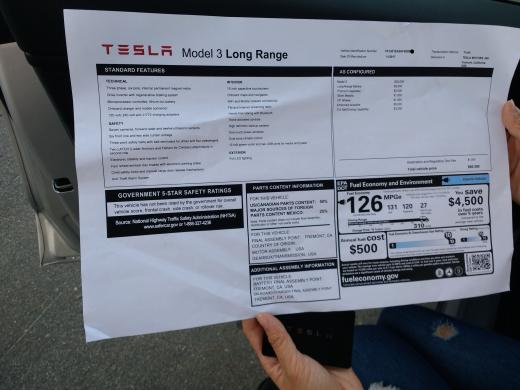
Monroney sticker was for $60,500, but the owner bought the non-functioning Full Self-Driving (FSD) option in addition to the partially deployed Enhanced Autopilot (EAP). EAP features are still being rolled out gradually via over the air software updates. FSD may never be available if governments ban it. Also got the required large battery pack at $9k and required Premium package at $5k.
The V-Spoke wheels look as beautiful in person as in pictures at $1.5k, however I am getting the base cost Aero wheels for their claimed 10% range advantage which is entirely possible due to incremental improvements attributable to details in a very low drag car. Small changes can make a very large difference when the drag is this low, so the smoother airflow over the Aero wheels indeed could account for much lower drag and significantly longer range.
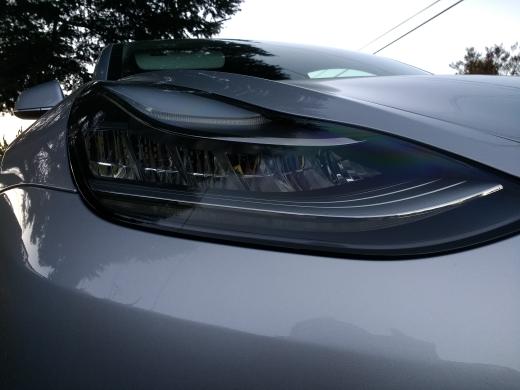
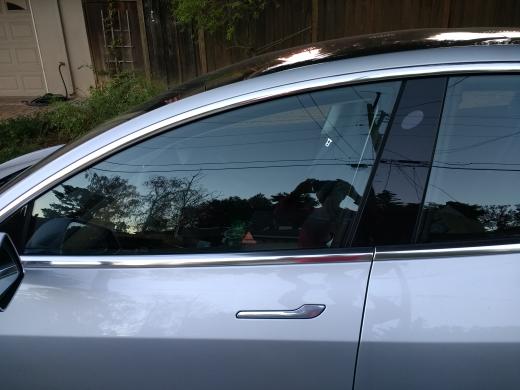
Again, the Model 3 proportions look slightly lumpy and pinched in photographs, but very nice in person. Perhaps the eye follows the lines in a more harmonious way as a life-sized, dimensional sculpture versus in pictures.
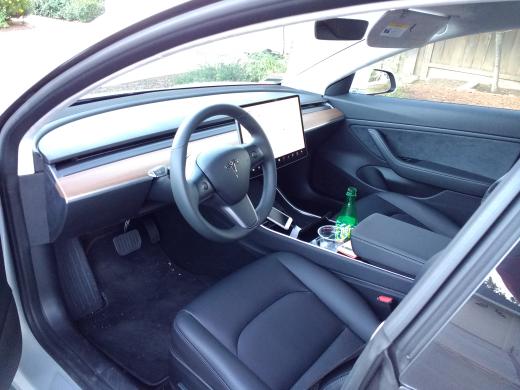
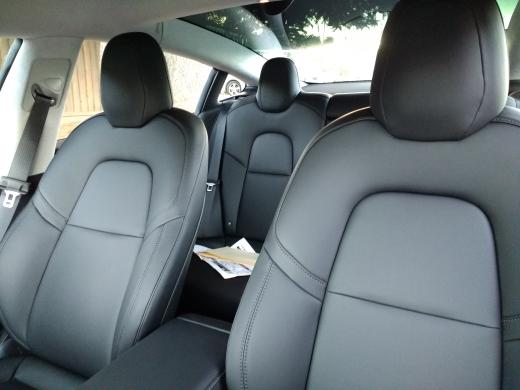
I sat in the Model 3 briefly, and it was very nice. The interior is pretty, and the sight lines are good. The very comfortable and supple high-end Ultrasuede polyurethane seats felt very much like current Model X seats, but a bit smaller. The stock black interior is very dark. The new Model S and X light beige interior may be the way to go. It's barely off white, like the foam in a latte. The pure white interior is almost painfully bright.
The center display is well-sized and positioned, and is not distracting. Its choice as computer interface is highly appropriate in an age of smart phones and touchscreen tablets. The interior materials are very high quality and elegant in a modern and understated way. The Alcantara on the doors, pillars and halo adds some luxury as does the wood dash trim. Overall it's very clean, tidy and pleasing. Very, very competent and tasteful design.
Many people may find it bland or cheap-looking if they prefer busier Baroque or Tokyo-by-night interiors with lots of buttons, knobs, displays, multiple binnacles, lights, cubbyholes, etc. I don't. The Model 3 interior is a modern art museum or zen garden, not the Ginza or Neuschwanstein Castle. It's Bauhaus, not bombast. Again, some people don't like it. Too bad for them that they lack the taste or cultural refinement to appreciate its beauty. Like the exterior, the Model 3 interior is a fine sculpture.
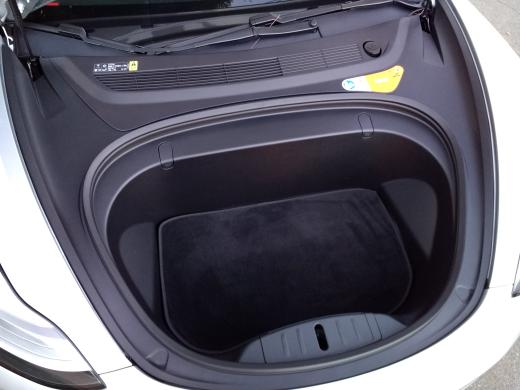
Model 3 frunk is much smaller than Model S and X, just large enough to fit a carry on bag, but the extra storage vice internal combustion is welcome. (Rear) trunk is large and much longer than most hatchback cars. Like other Teslas, Model 3 has additional storage in a deep compartment under the trunk floor, presumably behind the rear motor.
Overall impressions getting hands on and seeing the car up close and in person is that the size is good. Significantly smaller than the large Model S or X, Model 3 is sized about the same as its BMW 3 series and Audi A4 benchmarks, but is much sleeker looking; like a Porsche, if Porsches actually had good proportions and styling, which they generally do not. Due to the shape of the car, the whole feeling is much smoother and more flowing than the 3-box 3 series or A4 sedans. Model 3 is a sedan but projects as much more feline and lithe due to its curves; like a small Jaguar sporty car, not a Jaguar sedan, which tend to be blocky and chunky: shaped like rugby players these days.
Model 3's physical presence is excellent: exterior size, proportions, practicality, visibility from inside the car, interior volume and design, styling. This is a well-considered car. And that's not even addressing the world-leading suspension design, incredible torque, low center of gravity, long range, automation, energy efficiency about 12% better than a much smaller Nissan Leaf, intuitive user interface, novel air conditioning, etc. Speaking of the latter, the air conditioning vents are very thin and virtually invisible. Due to their large area, I expect them to be very quiet and effective.
Still have not driven a Model 3 yet. Will keep checking the nearby dealers to see when they have some.
10 October 2017
Spotted a Model 3 in Silicon Valley. At that point in time, they were very rare, probably fewer than 300 extant. As mentioned before, it looks much better in person. The proportions are much better balanced and make a pleasing overall form. In pictures, the proportions and lines seem slightly odd. Car was Midnight Silver Metallic with the V-Spoke wheels. (Click on the thumbnails below to get the larger image.)
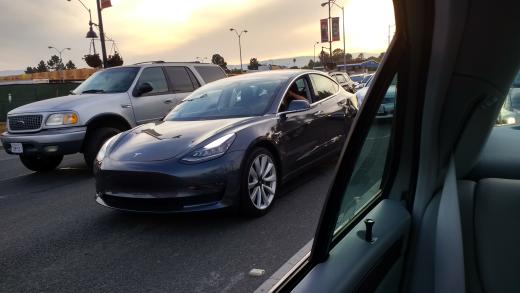
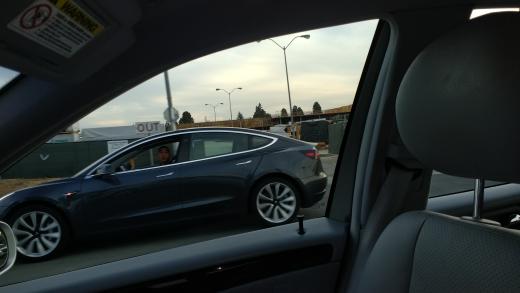

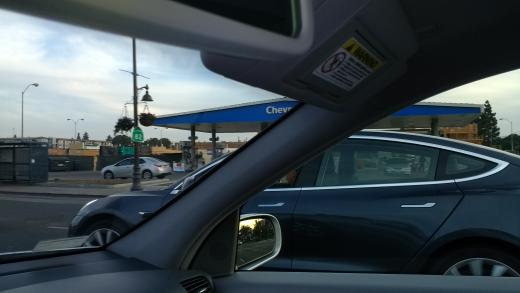
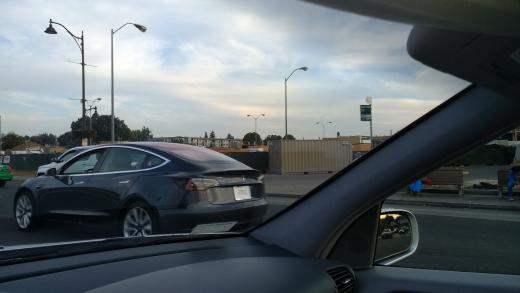
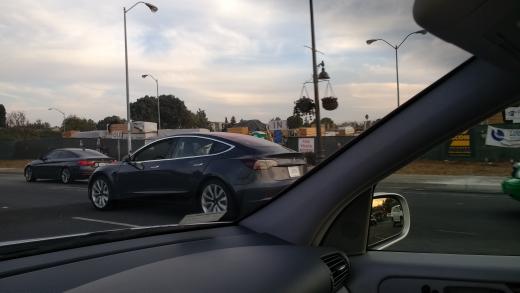
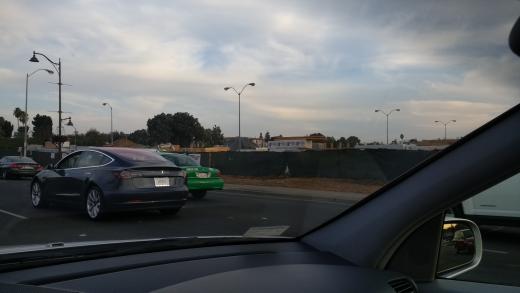
23 September 2017
I saw a Model 3 on the road for the first time a few blocks from my home in Silicon Valley. It was Midnight Silver Metallic. At first it was slightly hard to determine whether it was a Model S or Model 3. Only after noticing the upturned nose and the slightly smaller size did it become apparent that it was indeed a Model 3. (Since I was driving, and wasn't entirely sure what I was seeing, I did not take pictures; at first I thought it was a Model S.)
Given that a few hundred Model 3s have been produced to date, this was almost certainly an employee car. There are many Tesla employees (and customers) in the area.
Model 3 seems slightly but noticeably smaller, like a scaled down Model S. Initial impression is that it's smaller, curvier, and sexier than the slightly conservative and larger Model S. As others have reported, Model 3 is indeed much better looking in person than in pictures. The proportions of the nose and greenhouse are clean and lively. In pictures, the back of the car looks too large, but in person, it balances the rest of the car nicely.
The slightly curvier hunched back of the Model 3 together with the more pointy hips gives the impression of an animal ready to pounce. It gives energy and drive to the shape of the car. Model 3 takes the wallowing bloat (pregnant whale look?) of the Model X central greenhouse and turns it into something much smaller, quicker and lithely agile. The upturned nose is indeed a bit unusual, but appeared less pronounced and ugly than the unveil prototypes. The nose job definitely helped Model 3.
28 July 2017
Key specifications revealed by Elon for two initial versions of Model 3:
This equates to approximately 240 Watt-hours per mile for the previously announced large battery pack capacity of 75 KWh and a calculated 53 KWh for the smaller battery pack (probably 55 KWh given slightly lower efficiency of a smaller pack). 240 Watt-hours per mile is significantly more efficient than Model S and Model X. Most of the efficiency difference should be due to smaller size, lower mass, and better aerodynamics of Model 3. Dual motor Model 3s should be even more efficient and therefore have slightly longer range and quicker acceleration.
Elon also said that by the end of 2018 there would be three times as many Superchargers as today (end of July 2017).
Live streamed test drives showed a Model 3 interior vastly improved over current Model S and X: lots of storage, better materials, cleaner styling, very roomy back seat, highly practical. Almost everything is controlled from the touch screen, including ventilation direction, glovebox release, etc. Steering wheel tilt and telescope are controlled at the steering wheel scroll wheels/buttons, along with other functions when different modes are selected. There may be no stand alone physical buttons (aside from Federally-mandated hazard light button?). The touchscreen is very clear and may be 4k resolution.
User interface has car performance in the third of the screen towards the driver. Speedometer is prominent at the top, and autopilot very prominent below it. Map, rear view camera, web browser, etc., are on the two thirds of the screen away from the driver. Temperature and fan controls are at the bottom row of the 2/3, along with music, etc. Overall, the user interface looks very clean, efficient and logical, and is an improvement over current Model S and X. Presumably at some point Model S and X interiors and user interface may be refreshed along the lines of Model 3.
There has been much anti-selling of Model 3 by Tesla in order to not cannibalize Model S and X sales by the much less costly Model 3. One of the claims is that Model 3 is not a newer generation car. In fact, Model 3 very much seems to be a newer, improved generation of car with improvements in almost all aspects, but especially in functional and stylish interior design and even better user interface. Underneath, the battery cells, battery modules, battery packs, motor design and type, etc., are all new. Model 3 appears to be an outstanding car, and a significant improvement over Model S and X. It's also measurably more efficient.
Initial body colors are blue, red, pearlescent white, black, silver, midnight silver metallic. I still need to see the car in person in daylight to decide which one looks best. They all looked pretty good though I'm not a fan of white. Of course the color availability will change over time also. Wheels are the design-patented Aero and V-spoke. Aero is 18 inch. V-spoke 19. Turbine wheel from the initial unveil was not seen. Roofs may have all been glass, though metal roof and sunroof should be available eventually. Model 3 metal roof is used on an official anti-selling page.
More information, including more specifications and pricing of optional feature packages is in the Tesla 3 Press Kit.
Very significantly, Model 3 base weight of 3,549 pounds is about 1,100 pounds lighter than Model S, which may account for much of the very sharp handling Kim Reynolds reported in Motor Trend.
"The Model 3 is so unexpected[ly] scalpel-like, I'm sputtering for adjectives. ... Have I ever driven a more startling small sedan? I haven't. At speed, it gains a laser-alertness I haven't encountered before. By happenstance, associate road test editor Erick Ayapana had penciled me into a 2.0-liter Alfa Romeo Giulia to get here, and it feels like a wet sponge by comparison."Lighter weight also accounts for a significant difference in efficiency. Lower mass requires less energy to move around. Lighter is better, and Model 3 is significantly lighter than Model S. (Model 3 is about 25% smaller in plan view than Model S and weighs about 22% less, so some of the weight savings definitely comes from simply being smaller.)
[Wow, Motor Trend needs an editor who is both awake and has passed a basic English class; there's also typo in the third paragraph.]
For comparison the two-seat EV1 weighed about 3,100 pounds with a 1,000 pound battery pack. Call it 2,100 pounds without battery pack. The five-seat Model 3 weighs about 3,800 pounds with a 1,000 battery pack, or about 2,800 without. Model 3 is a larger car however, which of course adds mass, and it's built to tougher and much more modern crash standards.
3 April 2016
After the presentation, more information came out in YouTube videos of people getting test rides and Elon's twitter feed. Many of the YouTubed test rides were conducted by Doug Field, Tesla's Engineering Vice President. (Search YouTube for "Tesla Model 3 first ride" to find some.)
In terms of exterior styling, Model 3 is mostly a 20 percent smaller Model S with some of the nose and glass treatments of the Model X. For example the deep, front, header-less window of the X became the deep, rear, header-less window of the 3. The preproduction prototype 3 got some of the squared-off, and blanked-off nose of the X. Unfortunately this was one of the uglier elements of the X. Many people don't like it, and Musk has hinted it may be modified before production. The rest of the 3 exterior is a bit sharper and cleaner than the S. It's very good looking except for the nose.
Because of the smaller size, the front shrunk a bit in length, gained a bit in height or steepness, and is generally a bit more compact. It has a nice general shape that many people have likened to the Porsche Panamera, but which I think also has a bit of Ferrari 360 Modena. The general shape is very pleasing. However...
One criticism about the Model S which can be carried forward through X and 3 is that the general shape of the car, and particularly the nose, is based on a design language of internal combustion cars, in particular their need for copious cooling air. Combustion cars have large grilles to allow enough airflow to dissipate the 80% or so waste heat they generate. (They are about 20% efficient. In contrast, EVs generate about 20% waste heat; they are about 80% efficient. EVs have 4 times lower cooling needs for the same useful power output.) Because it draws from this design history, Model S has a black nose cone blocking off the opening where a grille would be in a combustion car. Model X closes off most of the the grille, leaving a tiny slit opening at the upper edge. It's strange, and the "missing grille" is a consequence of the combustion car design language. Apple's early graphical user interface design was also criticized for skeuomorphism.
While the resulting car shapes are generally pleasing and familiar, they also represent a missed opportunity to strike out in a new design direction that truly reflects the novel characteristics of an EV. EVs should not have a "mouth" that's closed off; they should use a design language that doesn't have a mouth. Admittedly such a form may appear strange to people, since we seem to mentally model cars as animals with a face, nose, mouth, eyes, etc. Model 3 continues this arguable design error and in a sense highlights it with mouth that's noticeably blanked out. The "missing grille" effect is symptom of an anachronistic premise in the inappropriately applied design language of combustion cars. EVs don't need a large grille and therefore shouldn't have a mouth, at least not if form follows function.
The flanks are sleeker and sharper than the Model S, in very much a Southern California school of design also seen in some of the Toyota Calty designs for example. In many ways they are an improvement. The sharper flank edges may act as vortex generators to improve the airflow trailing the car, keeping it attached to the car longer and reducing drag. It looks more aerodynamically correct than smooth rear flanks, which can lead to flow detachment, turbulence and increased drag. A large flat lip spoiler is stamped into the rear trunk lid. All of the details, smooth front, sharper rear, and overall clean design may contribute to a hoped-for 0.21 drag coefficient, which would match Volkswagen's limited-production XL1 but not the 0.19 of GM's production EV1.
The greenhouse is one large, graceful, aerodynamic, curving arch from the base of the windshield to the trunk. It's aesthetically very pleasing and probably good for drag, but for safety I'd like to see more steel and less glass. The large greenhouse may add to the internal thermal load also, though the glass surely has some heat management properties. The concept of a tall, long, smooth, curved greenhouse seems carried over from X, but is better-proportioned in smaller 3. The greenhouse is still a bit too large in Model 3, but it's good looking.
As mentioned above, I find the 3 interior a significant improvement over S, which is in comparison a bit busy. 3 is definitely highly minimalistic on the inside, but follows Bauhaus principles of keeping it very simple, clean and functional. I thought it was a bit stark at first, but like it very much now. It's a lot like the futuristic spaceship interior in Stanley Kubrik's 2001, or indeed Musk's Dragon v2 space capsule. Model 3 has a very different interior design language than S; much cleaner. At the same time, I'm sure there will be people who won't like it. I prefer classical minimalism and functionality over baroque filigree; Bauhaus over Rococo.
Tesla benchmarked the EV1's 0.19 drag coefficient and may not have quite met it, but it's very clear they had EV1 on their minds. EV1 may have been one of the reasons Tesla was started in the first place. It was truly shameful that GM built such an incredibly advanced car in the EV1 then took it back and crushed them.
EV1 had no dashboard, instead placing instruments in a band directly below the windshield. Model 3 has a similar band and could put instruments there. If so, it would be a direct homage to EV1. Even if Model 3 doesn't put instruments in the band below the windshield, it may have been influenced by EV1's lack of driver side instrument binnacle and low, pushed forward dash. EV1 had a somewhat protruding center console with pushbutton controls and vacuum florescent displays, were Model 3 has a more protruding center touchscreen control. EV1 had a broad, unusually tall, flat center tunnel housing some of the batteries and providing an arm rest, cup holder, change pocket, shift lever, etc. Model 3 has its batteries below the floor, but adds a broad, flat center console missing from Model S. Model 3's center console has cup holders and a possibly adjustable arm rest.
Some of the details and maybe some of the shape of Model 3 are reminiscent of EV1. The rear trunk opening is almost exactly as I remember EV1. The main difference is that EV1 had curved struts locating the trunk lid that attach inside the trunk, while the Model 3 prototype has shorter struts near the top where the upper arms of the trunk lid meets the C-pillar. This exposes the shorter strut mechanism to more weather. The water channels around a weatherstripped dam wall protruding up from the trunk opening is exactly as EV1 handled it.
Also the general shape of the Model 3 is like a slightly curvier EV1. One difference is that the EV1 was strongly curved-in front to back in plan view where Model 3 is probably more squared off. But the somewhat wedgy front ends of both cars is similar in philosophy. The wedge blends in from the sides in a curve that's somewhat EV1 like. At least a little of the EV1 design and sprit lives on in the Model 3. Model 3 is better looking. EV1 had 10% lower drag.
Many of these are relatively small details, even if they're really positive and cool. The big picture impact is that the reception of Model 3 has been incredibly enthusiastic, with likely the first couple years of production already reserved. That's amazing, and perhaps what happens when you make a great-looking, modern, less-polluting, great-performing, great-driving car that can also drive itself, etc. Also EVs cost about a third to quarter as much to operate as internal combustion, so there are major economic benefits over a similarly-priced combustion car, and 35k to 45k is pretty mainstream pricing. Future owners may not realize this aspect yet, but they will save many thousands of dollars over buying gasoline. Tesla built a great brand and great car with the Model S in particular, and it's paying huge dividends in orders for Model 3.
Certainly Tesla may dominate the near-term EV market, but I hope it's the start of mass adoption of EVs in general. If so, Tesla will deserve a lot of credit for getting it started.
A related, interesting question is what happens to the rest of the car industry. Sure 200k cars is a small fraction of global annual production of about 100 million, but the popularity of the car must cause concern for the benchmark competitor BMW 3 series, Mercedes C class, Audi 4 series. Hopefully it pushes more manufacturers into EVs just to stay competitive. GM is really the closest with the 200-mile-range Bolt, and it may get wiped out by the similarly priced but much more sophisticated, better looking, and more advanced and automated Model 3. BTW, GM could have owned this market by continuing to build and develop the EV1 while advancing battery technology, just like Xerox could have owned the GUI PC market long before Apple and Windows. Instead, GM literally crushed their incredibly advanced EV1.
The grassroots support for this car is amazing. 100k people ordered without seeing it; and 200k more ordered knowing they would not get a car for a couple years. How many other cars in history had 300k+ pre-orders? Very likely none.
People going to the stores to place their orders noticed that the mix of cars in the parking lot was mainstream: SUVs, Hondas, Camrys, minivans, and only a few Teslas and Leafs. These are ordinary Americans, not radical eco-warriors, hypermilers, etc. That's a great sign of mainstream adoption. And apparently they want an amazing car. :)
Once you go electric you never go back. The instant torque is addictive, even on lower-powered cars, and the operating costs are a small fraction of gas or diesel. Getting the battery cost curve down is critical and especially with Gigafactory, we may have already passed the point of no return for combustion cars, even if most people don't realize it yet.
I wish the Model 3 great success and hope it's the start of a new era of much more efficient, cleaner driving. It's off to a great start and EVs couldn't have a better representative than the Telsa Model 3!